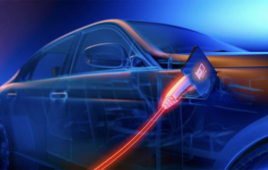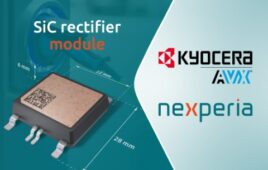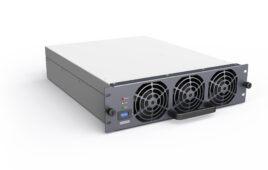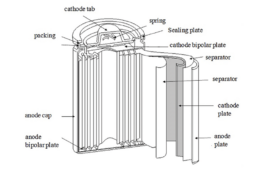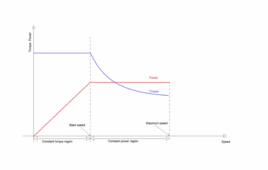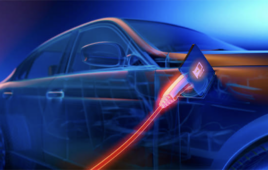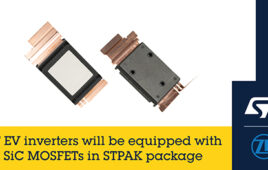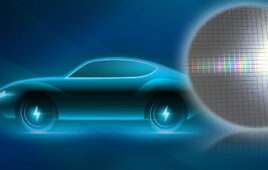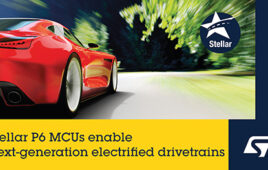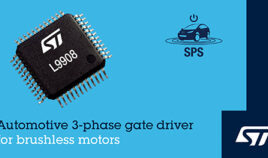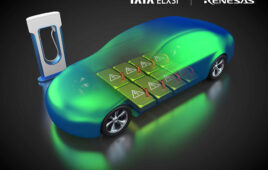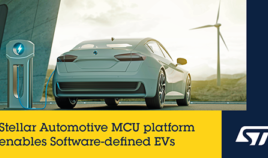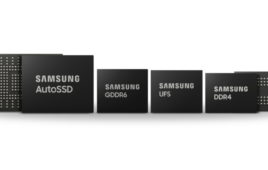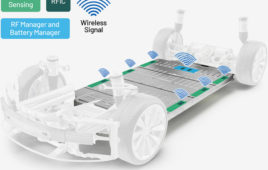Electric vehicles (EVs) are reshaping the automotive industry in terms of sustainability and technology. Not only are EVs reducing greenhouse gases and dependency on fossil fuels, but these vehicles are also driving innovation in aerodynamics, lightweight materials, batteries, powertrains, inverters, software, advanced driver-assistance systems (ADAS), charging systems, cables, and much more. There have also been…
Nexperia and KYOCERA AVX to produce silicon-carbide rectifier module
Nexperia, a semiconductor provider, announced it has entered into a partnership with KYOCERA AVX Components, an international supplier of advanced electronic components, to jointly produce a new 650 V, 20 A silicon-carbide (SiC) rectifier module. The new rectifier module will be for high-frequency power applications ranging from 3 to 11 kW power stack designs —…
Infineon and Infypower partner to advance EV charger market
Power semiconductors based on silicon carbide (SiC) offer several advantages like high efficiency, power density, voltage resistance, and reliability. This creates opportunities for new applications and improved charging station technology innovations. Infineon Technologies announced a collaboration with Infypower, a Chinese provider of new energy vehicle charging. Infineon will provide INFY with the industry-leading 1200 V…
Renesas and Nidec partner on E-Axle semiconductor solutions for EVs
Renesas Electronics Corporation and Nidec Corporation have joined forces to develop semiconductor solutions for the next-generation E-Axle (X-in-1 system), which integrates an electric vehicle (EV) drive motor and power electronics for EVs. Today’s EVs are increasingly adopting the 3-in-1 unit called E-Axle, which integrates a motor, inverter, and gearbox (reduction gear). To ensure high performance…
What battery chemistries are used in electric vehicles?
Despite a higher price tag initially, electric vehicles (EVs) tend to offer significant savings over time. The environmental benefits aside, which are noteworthy, EVs typically cost half as much to maintain and repair as gas-powered vehicles — and they’re growing in popularity. Unlike conventional vehicles, EVs don’t have internal combustion (IC) engines. Instead of gasoline,…
What are the different types of EV charging connectors?
Battery electric vehicles (EVs) have showcased rapidly growing sales figures over the last several years. There are several reasons to consider an EV aside from saving on gasoline. The prominent one, of course, is the environment. EVs have no tailpipe emissions, and research shows that they’re responsible for lower levels of greenhouse gases (GHGs) than…
What types of motors are used in electric vehicles?
Conventional vehicles that rely on internal combustion engines (ICE) could become a rarity in the next couple of decades. Electric vehicles (EVs) are growing in popularity, replacing petrol-driven transportation faster than expected. Despite a higher initial price tag, EVs typically offer savings over time. The environmental benefits aside (which are noteworthy), EVs cost half as…
What is the role of embedded software in electric vehicles?
Electric vehicles are the future of the automotive industry. There are already more than 2.5 million BEVs and PHEVs in the United States this year, which is expected to increase. There are more than 2.3 million electric vehicles (EVs) in Europe. In India, the number has surpassed 1.3 million. Battery aside, one key factor to a successful…
ZF relying on STMicroelectronics for silicon carbide devices
The technology group ZF will, from 2025, purchase silicon carbide devices from STMicroelectronics, a global semiconductor provider serving customers across the spectrum of electronics applications. Under the terms of the multi-year contract, ST will supply a volume of double-digit millions of silicon carbide devices to be integrated into ZF’s new modular inverter architecture going into series production in…
Renesas unveils new-generation Si IGBTs for EV inverters
Renesas Electronics Corporation, a premier supplier of advanced semiconductor solutions, announced the development of a new generation of Si-IGBTs (Silicon Insulated Gate Bipolar Transistors) which will be offered in a small footprint while providing low power losses. Aimed at next-generation electric vehicle (EVs) inverters, AE5-generation IGBTs will be mass produced starting in the first half…
STMicroelectronics introduces Stellar P6 automotive MCU for EVs
STMicroelectronics, a global semiconductor provider serving customers across the spectrum of electronics applications, has unveiled new microcontrollers (MCUs) targeting the coming electrified drivetrains and domain-oriented,over-the-air-updateable systems that are the foundation of the next generation of EVs. As the vehicles generate, process, and transfer large data flows, especially to support the next generation of EVs, ST’s…
Microchip introduces inductive position sensors for EV motor-control applications
Developers of motor-control systems are rapidly replacing Hall Effect position sensors and older magnetic resolver solutions with inductive alternatives that eliminate expensive magnets and other heavy transformer-based structures so they can be integrated onto simple, compact printed-circuit boards (PCBs). Extending the world’s broadest line of inductive position sensors into the EV motor-control market, Microchip Technology announces…
Vishay’s new chassis-mount, wirewound resistors provide stability for EVs
Vishay Intertechnology has introduced a new series of AEC-Q200-qualified, chassis-mount wirewound resistors, targeted at the growing electric-vehicle (EV) market. Vishay Dale RHA series resistors mount directly onto a chassis, using the heat-sink effect. Offering high reliability, the devices feature a completely welded and molded construction for total environmental protection, and an operating temperature range of -55°…
STMicroelectronics’ automotive gate driver boosts motor-control flexibility
STMicroelectronics’ L9908 automotive, three-phase, gate-driver unit (GDU) operates in 12, 24, or 48V systems and has flexible input and output channels to fulfill several applications in conventional and hybrid/electric vehicles. Dedicated source connections to the high-side and low-side FETs (field-effect transistors) of each half bridge let users configure the output channels independently to drive various types…
Vishay offers new, AEC-Q200-qualified wirewound charging resistor
Vishay Intertechnology has introduced a new, AEC-Q200-qualified charging resistor that is the industry’s first device to feature hybrid wirewound technology in a standard package size. With a high operating temperature range up to +250° C, the Vishay MCB HRHA will serve as a pre-charge and discharge resistor in inverters and converters for electric (EV), hybrid electric…
Tata Elxsi and Renesas establish Next-Generation EV Innovation Center
Tata Elxsi, a global provider of design and technology services, and Renesas Electronics Corporation, a supplier of advanced semiconductor solutions, have announced their collaboration on a state-of-the-art design center in Bangalore that will develop targeted solutions for electric vehicles (EV). The new Next-Generation EV Innovation Center (NEVIC) was opened in January of this year. EVs…
STMicroelectronics launches microcontrollers for software-defined electric vehicles
STMicroelectronics, a global semiconductor provider serving customers across the spectrum of electronics applications, has unveiled new automotive microcontrollers (MCUs) optimized for electric vehicles (EVs) and centralized (domain and zonal) electronic architectures. They enable EVs to become more affordable, drive further, and charge faster. In current EVs, high-efficiency SiC-based (silicon carbide) power modules enable the greatest…
Samsung unveils advanced automotive-memory solutions for EVs
Samsung Electronics, a global provider in advanced memory technology, has unveiled an extensive lineup of cutting-edge automotive memory solutions designed for next-generation autonomous electric vehicles (EVs). The new lineup includes a 256-gigabyte (GB) PCIe Gen3 NVMe ball grid array (BGA) SSD, 2GB GDDR6 DRAM and 2GB DDR4 DRAM for high-performance infotainment systems, as well as…
NI and D&V Electronics collaborate to expand EV testing system
NI, a developer of automated test and measurement systems, recently announced two new offerings to enhance testing environments and workflows for electric vehicle (EV) traction inverter validation: a new Inverter Test System (ITS) and a collaboration agreement with D&V Electronics for power-level inverter test. These offerings promise to accelerate innovation for EVs by integrating test…
Analog Devices’ wireless BMS supports Lotus Cars’ EVs
Analog Devices, Inc. (ADI) announced that the British performance brand, Lotus Cars, is planning to incorporate ADI’s wireless battery-management system (wBMS) in its next-generation electric vehicle (EV) architecture. ADI’s wBMS was selected for its increased design flexibility, battery repairability, and lighter weight. The engineering collaboration will enable Lotus to safely propel its future EV fleet…

